As you read this blog you might get the impression that I wasn’t too impressed with Germany. That is somewhat true, but it was less Germany’s fault than Bill’s. To simplify our travels across a country the size of Germany we rented a car (carrying all our luggage onto and off of trains is a pain in the butt). Bill then took advantage of this freedom to add stops along every drive day and ensure we visited way too many castles. I’m not a big castle fan to start with, since I much prefer palaces, so this did not contribute to my enjoyment of Germany.
(In my defense, I like castles, it’s a guy thing. I would point out that I complain a lot less about all the churches we visited than Dessa did/does about the castles. I will also admit to looking for and then planning to visit too many sites along our drive day routes – several of which weren’t really worth the detours although I enjoyed them).
Final comment, since we waited over 18 months to post this, we decided to cover all of Germany in 1 blog. It is therefore a little longer than normal so grab your beverage of choice and get comfortable…
On arrival in Berlin our AirBnB (which was actually part of a hotel), had another one of those automated check in systems and of course it didn’t work. Almost an hour after arrival, a live person finally appeared that could check us in. Other than that, the unit was great. It was very nice with windows on two sides and a large patio overlooking a park. On our first day of sightseeing we strolled along the Spree River to Museum Island and the Berlin Cathedral. The cathedral’s interior was covered in pale plasterwork, with golden frescoes in the domed ceiling, and we climbed the 36 flights of stairs to the top of the tower for some nice views of the city. A short Uber later we arrived at the Reichstag Parliament Building, billed as “one of the top sights” in Berlin. Our visit was disappointing as the bulk of the front of the building was covered/hidden due to construction in the courtyard.
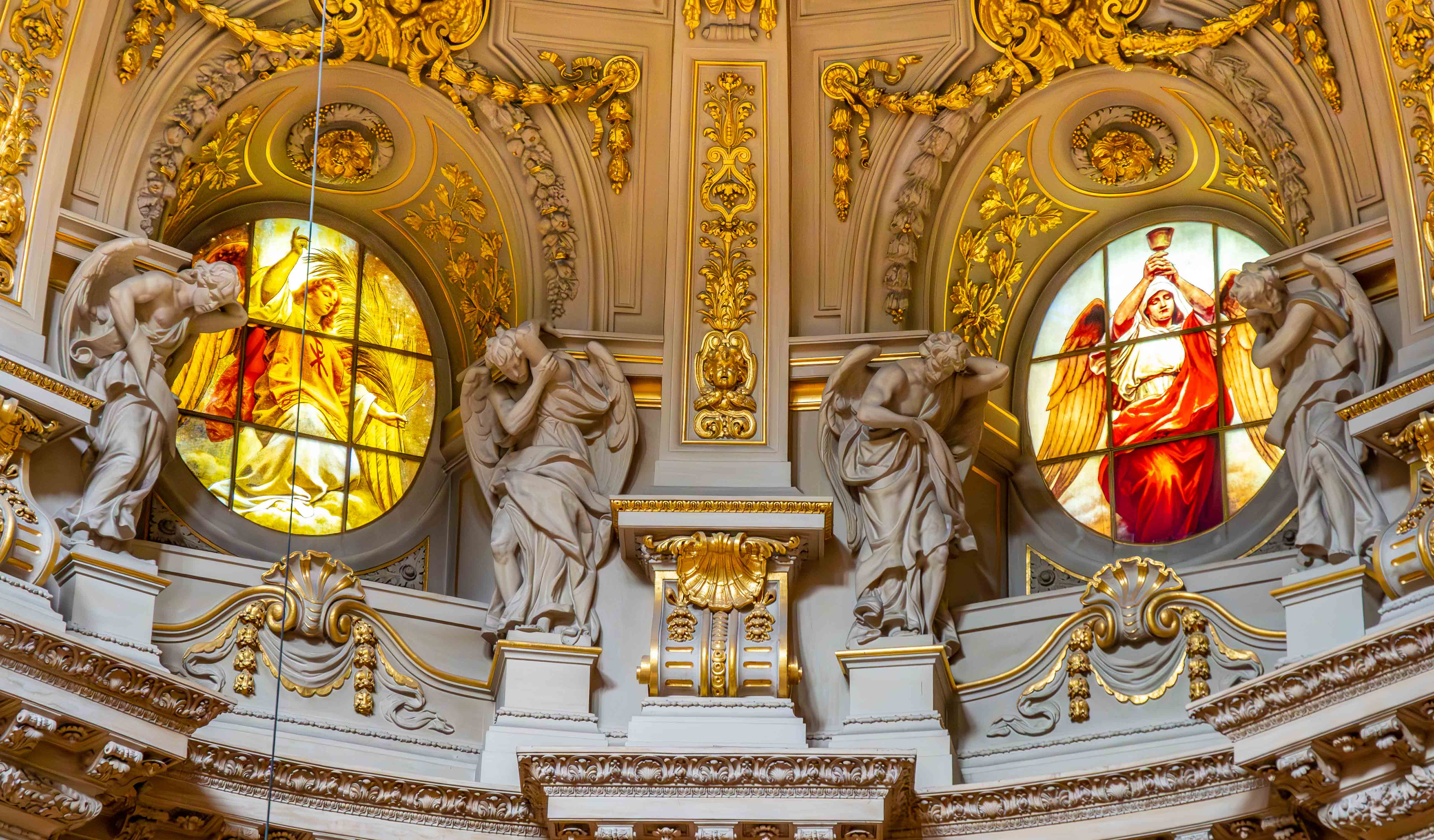
Nearby however was a nice park with a memorial to the Roma (often referred to as Gypsies). They were the first population considered to be ‘racially undesirable’ by the Nazis. Beginning as early as 1933, the Nazi’s determined that the Roma people carried ‘degenerate blood’ and genetically criminal characteristics. Their persecution began with forced sterilization eventually leading to mass execution. We later visited the Berlin Wall and Memorial, Checkpoint Charlie, The Topography of Terror Museum, and the Memorial for Murdered Jews of Europe. It was horrifying (as you might imagine) and sobering to read about the rise of Hitler and the subjugation, torture, and murder of nearly six million Jewish people. (I’ve always found it interesting that a guy who looked like Hitler could convince so many people that he should be the protector of the physical perfection of the master race).
I love historical novels, and have read many from various perspectives surrounding WWII. The common theme, no matter how they were caught up in the conflict, was extreme suffering. In total it is estimated that 50+ million military and civilian people died as casualties of war and another 20-ish million civilians perished as a result of famine and disease. All due to the radical, racial beliefs of one man and his followers. A history we should “Never Forget” … or repeat.

(There is no doubt that the German people suffered following WW1 and the great depression. Hitler and his cronies were unfortunately too successful in convincing the German and Austrian people that all their anger and frustration with their lives was caused by identifiable minorities and could be improved through persecution. Of course, the lives that were the most improved belonged to Hitler and his cronies)
While there are a few buildings in Berlin that survived the bombings in WWII, or have been restored, most were only functional, rather than decorative. This makes Berlin a lot less attractive than the other major cities we’ve visited in Europe. It is a large city, and the key sights are some distance apart, so we walked a lot, and used public transport. On the day we had tickets to Charlottenburg Palace we decided to get scooters rather than walk 90 minutes, or take multiple buses. European cities have extensive bike lanes, and we used those, but some sections were cobblestones, and they are super rough on a scooter. I thought I was going to have shaken brain syndrome by the time we arrived. The Palace was not too impressive from the front, but inside it had some absolutely beautiful rooms. Amazing ceiling frescoes, wall treatments, paintings, plasterwork, and tons of sparkling chandeliers. We opted for an Uber home (it cost about the same as our bumpy scooter ride so that was the last of our scooter adventures).
I read that at Mauer Park on Sunday’s there was street food and a flea market. When we got there, we discovered it was a massive hang out destination for mostly young people to drink beer, play loud music, and cook dinner (the street food was practically non-existent and the flea market was tiny but there was a celebratory carefree atmosphere). A pall of smoke hung over the whole park, because every few feet there was a smoking grill cooking sausage (mostly). It looked like there were grills that you could grab and take to your spot…if you could find a spot (for those that couldn’t grab a grill, people had camp stoves or impromptu charcoal fires with foil grilling pans). It was seriously crowded, and those that were not grilling, sat on the hill in the 3-foot-tall grass. At the top of the hill was a wall, where every few feet there was a street artist busy painting over last week’s designs. We were unprepared, with neither beer nor food to grill, so found a nearby restaurant where we had some excellent veal schnitzel.
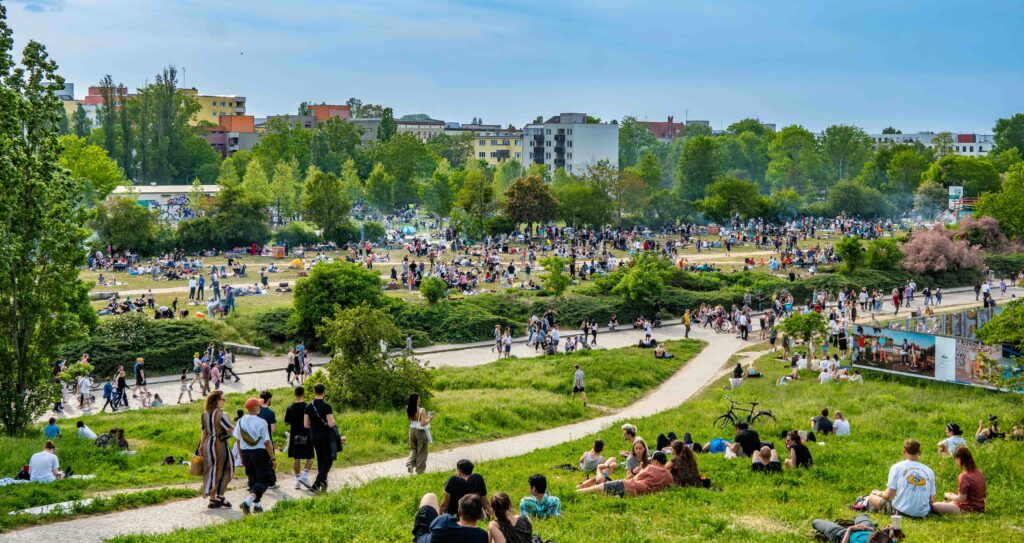
After a week in Berlin, we headed to Dresden, with a stop in Potsdam along the way, to see the grounds of Babelsberg Palace and Sanssouci Palace. Babelsberg looks more like a new castle, and Sanssouci was a long, low, yellow structure with many sculptures of weird looking men that appear to be holding up the building. This is a common theme in European architecture. We also took a detour to the Rakotzbrücke (The Devil’s Bridge), so named because “only the devil would build such a bridge”. It was a perfect half circle that was intended to be walked on to cross the river, but they don’t allow that anymore. The reflection in the river completes a full circle, and we got lucky. This time we were there at the right time on a calm day to get the full circle picture (and without any selfie seekers getting in the way).
In 1945, Dresden was hit with over 2700 tons of bombs which almost completely destroyed the city. After the war, the local leaders insisted that the city center be restored to its previous grandeur, and it is currently lovely with many ornate buildings. The Kathedrale Sanctissimae Trinitatis, or Dresden Cathedral, was the most ornate of all, with 74 life size statues on the rooftop. Most of the statues are covered with many years of grime and soot, but cleaning them causes too much damage so they remain blackened. We climbed yet another tower to get views of the Cathedral roof and the Elbe River which flows through the city.
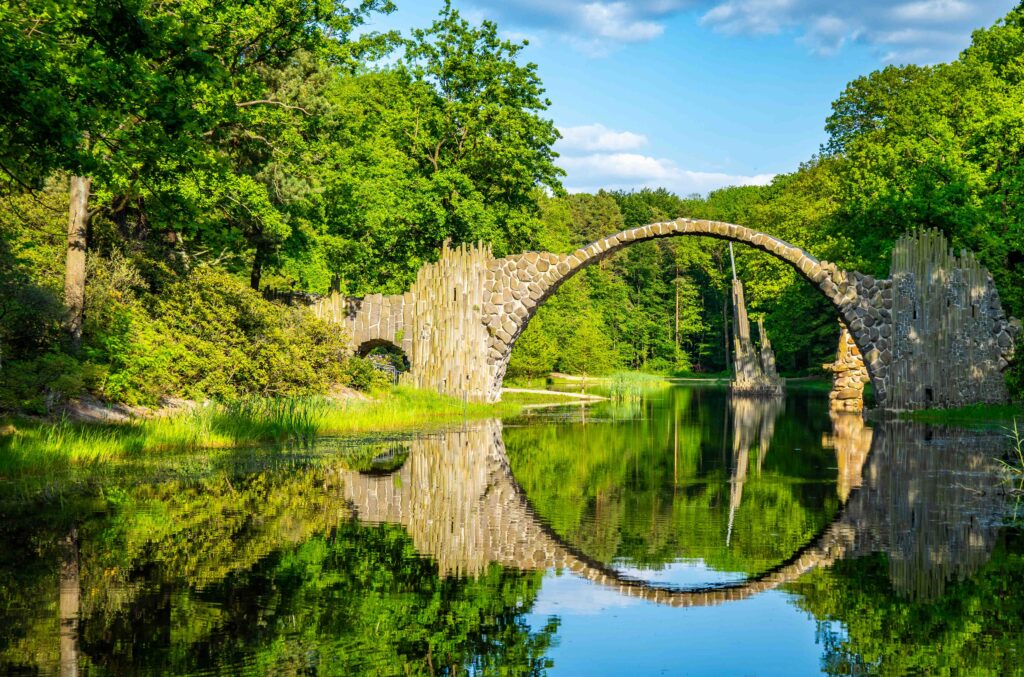
In the Dresden Residential Palace, we chose to visit the Neues Grünes Gewölbe (The New Green Vault), as opposed to The Historical Green Vault, both are museums. We are not generally big fans of museums but this one was beautifully staged and well worth the visit. The first display we came to was the armory (Our grandsons would have loved it. I did!) which held about a hundred intricately detailed swords and daggers (and battle axes, lances, cross bows and of course suits of armor). I am usually not interested in weapons and armor, but these displays were great.
Past the armory, they had a fantastic collection of other exquisite items and displays but the crowning glory in our opinion was the model of the “Birthday of the Great Mogul Aurangzeb”. It was created by court jeweler Johann Dinglinger over the course of three decades, and purchased at a staggering sum by Augustus the Strong. It contains 164 miniature enameled figures created in gold with 4,909 diamonds, 160 rubies, and 164 emeralds. I would imagine The Historical Green Vault was just as impressive, and I think we should have gone to both. Next time…
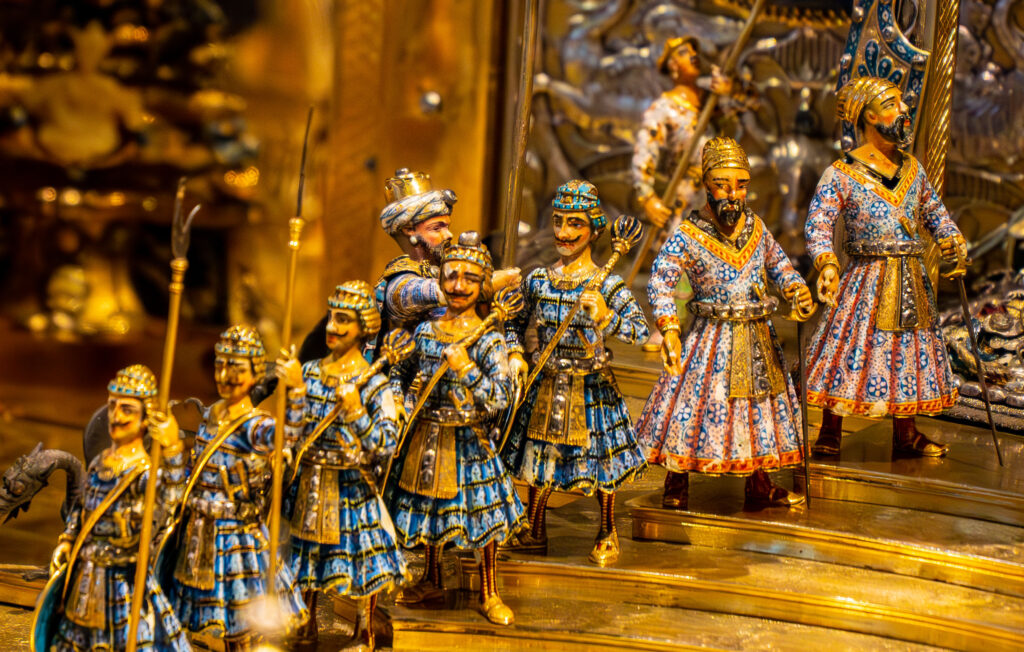
The next day we headed to Bamberg for an overnight stay and a visit to the Seehof palace. We enjoyed the drive through the beautiful Saxony countryside, all lush green fields and tree covered hills but we were jealous of all the motorcycles on the twisting roads. Bamburg was the first of the so called “Romantic German Towns”, and it was cute, but romantic? The Seehof Palace was billed as fully restored but it was obviously still under repair when we visited. Most of the exterior was freshly painted and there was a large fountain featuring Samson at the bottom of the garden. (Interesting but not worth the side trip)
Crossing into Bavaria, we arrived in Nuremberg early on a Sunday, so we started right in on our sightseeing list, only to find pretty much everything was closed (we still struggle to get used to that). Sankt Lorenzkirche (Saint Lawrence Church) was built in the 1400’s, and the entry arch was adorned with good examples of the strange sculptures we have seen everywhere. The church was very badly damaged in WWII, but the religious artifacts were protected by the citizens and the building was restored with their generosity. Inside there were many sculptures on the tall columns, and the most prominent artifact was a large circle, hanging from a chain over the altar, depicting “The Annunciation” where the angel Gabriel announced to the Virgin Mary that she would conceive a son by the Holy Spirit. There was also a 65-foot-tall sandstone tabernacle known as “Sakramentshaus”. (The churches in Germany have been very different from those in Spain. Spain’s felt brighter and lighter with more color. Germany’s have a heavy, somber feel and often have a military presence)
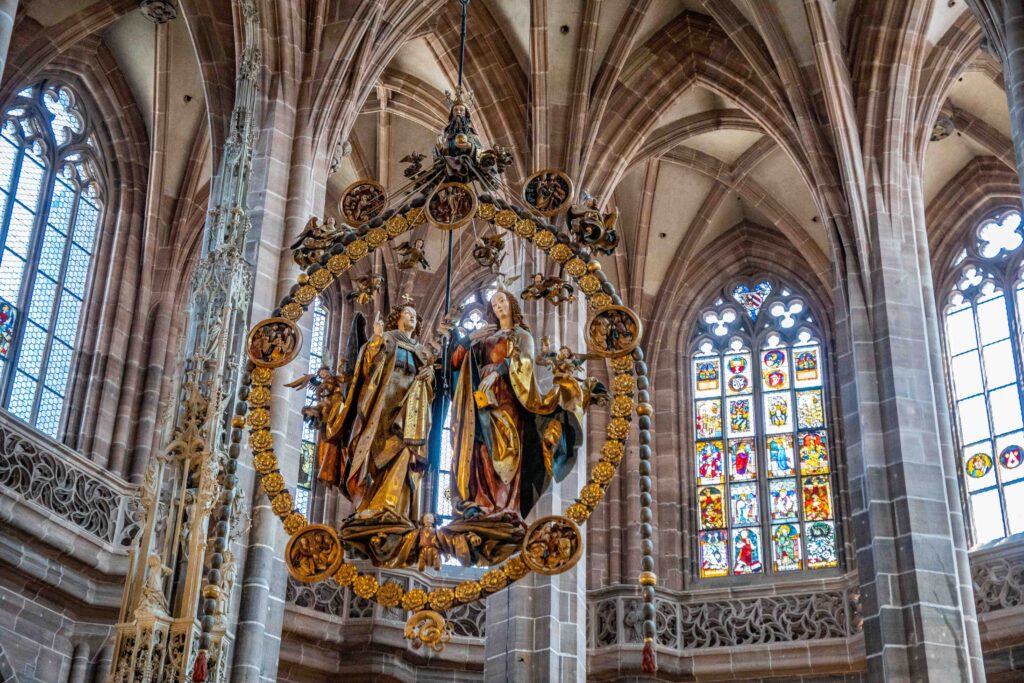
With two days in Nuremberg, we went back on Monday, only to find it was a religious holiday, and everything was still closed. When I say everything, that is what I mean. A few restaurants were open, but no stores, no groceries, not even convenience stores. We wandered the town again taking pictures and visited St. Sebald Church which was open. Just below the church, a few patio restaurants were open so we stopped for a late lunch and Bill made me try the local bratwurst sausages (I got a few strange looks after I tied her to her chair and force fed her the sausage but you gotta do what you gotta do). I generally don’t eat sausage or any kind of mystery meat, but they were ok (they were excellent), pretty much like breakfast sausage. After lunch we walked back to the Hauptmarkt to see the Schöner Brunnen again (still crowded with tourists making picture taking difficult – why don’t these people stay home?? ;-). It is a beautiful fountain with a 60-foot gothic spire surrounded by forty painted figures, representing The Holy Roman Empire. Built in the 14th-century, it has two brass rings that were being spun by all the tourists because they are supposed to bring good luck. Our Airbnb was yucky (primarily the bedroom, more accurately described as a closet barely large enough for the double bed), so I was glad to put Nuremburg behind us and move on to Munich.
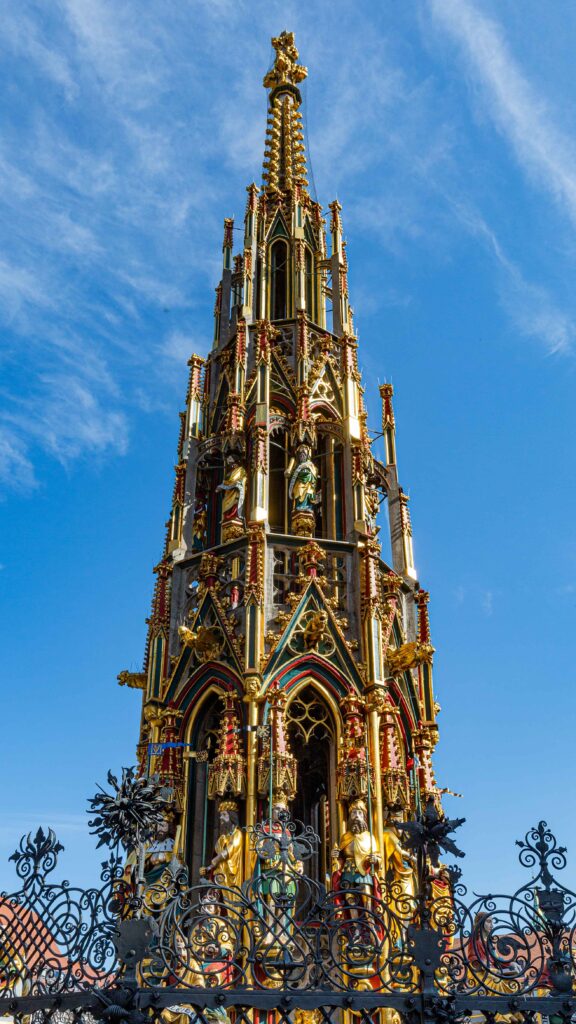
Of course, Bill had us stopping in two towns along the way to Munich. Wurzburg and Rothenburg ob der Tauber, also considered “Romantic German Towns”. They have winding cobbled streets lined by peaked houses with crosshatched timbers and flower box decorations. Of course, the official pictures you see on line have no cars, or construction, or trash cans, or people except for the loving couple holding hands and admiring the beauty of the town. Not even close to our reality, but we did our best to capture some semblance of the fantasy. (Both towns were interesting to visit and in Rothenburg we tried a local treat called a Schneeballen. It was very popular given the number of stores selling them and the varieties available but I didn’t think it was that good. It is essentially strips of pie crust, rolled up into a ball about the size of a baseball and then deep fried and covered with sugar, icing, chocolate, … I found it bland and dry.)
Our Munich Airbnb was about 30 minutes from downtown, and it was a brand new three-bedroom apartment. Large, modern, and clean. It was excellent. We drove into town and parked near Marienplatz, a large open square in The Old Town, featuring the New Town Hall (“NEW” but completed in 1874) and the Rathaus-Glockenspiel. The Neo-Gothic building looks much older than it actually is (maybe that’s why they call it “NEW”), with tons of decorative spires, sculptures, towers, and gargoyles. It is a full block long, where more than 600 government employees work in just over 400 rooms. The Glockenspiel is a huge clock with 32 life-sized figures. At 11 and 12 o’clock it chimes and re-enacts the 1568 marriage of Duke Wilhelm V to Renata of Lorraine with the celebratory joust on the top half, and the Schafflerstanz (Coopers Dance) on the lower half. We got a table at a sidewalk café so we could watch the show as the square filled with tourists (and ate very overpriced and not very good food).
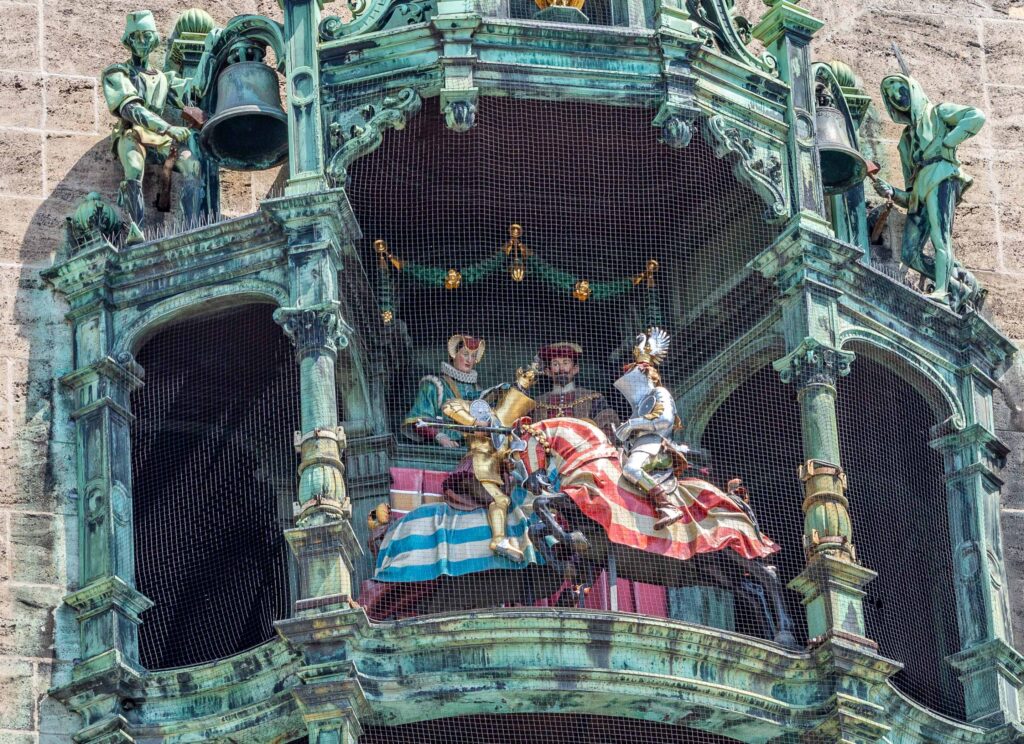
Nearby the Munich Residence is the largest city palace in Germany containing 10 courtyards and 130 rooms, and I think we toured all of them (with very little grumbling from me. Commentary sure but little grumbling). Many of the rooms were really pretty amazing, they had fantastic murals on vaulted ceilings, a wide variety of wall coverings, and very intricate tile work on the floors. There was not a lot of furniture in the rooms, but even the empty rooms were extraordinary. We lunched at Hofbrauhaus, the beer hall where Hitler held his first meeting, and one evening we met friends of Bill’s from his Nortel days (Thanks for meeting us Jim!) at a beer garden for huge mugs of beer (easily ½ gallon) and pretzels bigger than your head. It was quite an experience, with hundreds of people enjoying the lovely weather at picnic tables under the trees. (Given the cumulative volume of beer being consumed, it was surprisingly quiet as family and friends enjoyed each other’s company and conversation. At one point a few guys did get up on their picnic table to sing loudly but that ended pretty quickly)
The churches we visited were quite a contrast, Heilig-Geist-Kirche offered some elaborate plasterwork adorning the tall white columns and ceiling murals, and Asamkirche was the total opposite with dark wood, strange sculptures, and dark murals in a narrow space. Surfers on the Eisbach River were fun to watch, and the English Garden was a huge park in the middle of the city featuring its own large beer garden and Chinese pagoda.
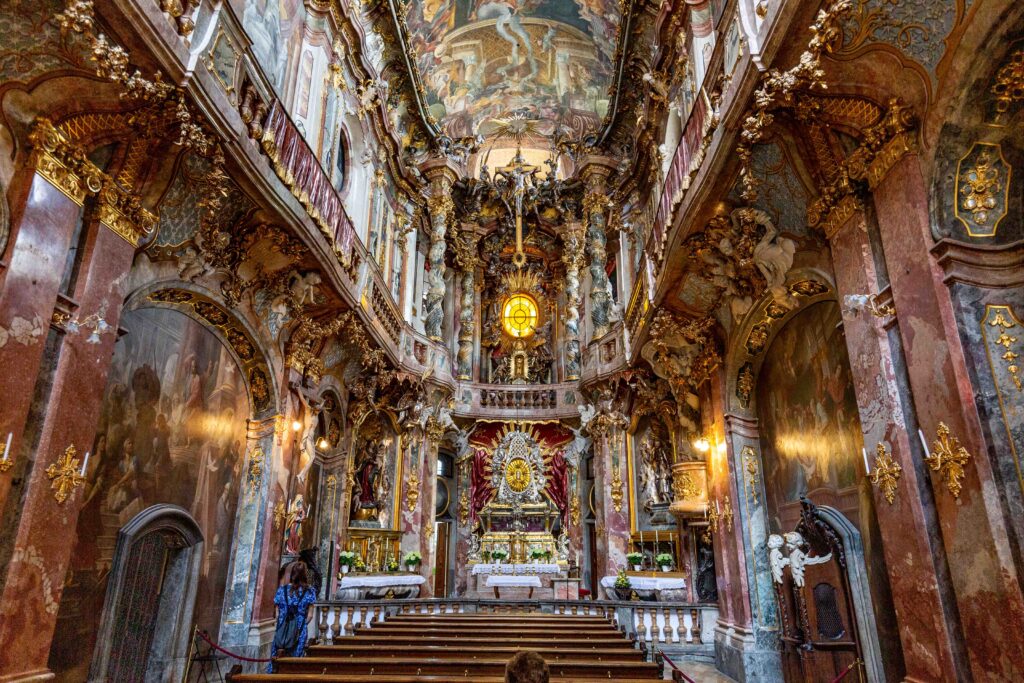
A day trip took us to see Neuschwanstein Castle, a beautiful white structure in the foothills of the Alps near the Austrian border. It is perched above a gorge, built in the late 1800’s, and looks a bit like the Disney Castle. Because we read that the crowds could be a problem, we arrived at 8:00am, only to discover that the first bus up the steep hill to the castle would leave “about nine”. When a horse draw wagon appeared, we paid 8 Euro’s each for a ride with ten other visitors. The wagon took us to the castle, then we walked farther up the hill to a bridge where we had a great view of the castle and the town below in the valley, as well as views of Hohenschwangu Castle. Rather than pay again for a ride back down to town, we opted to walk, and Bill decided we should take the trail rather than the road. Not only was it very steep, it was all rocks and roots, very narrow, and not marked at all. Based on previous experience (One time! I got us lost one time and she won’t let me forget it), I grew concerned that we were lost in the thick woods, when we saw no other people going either way. I will admit I complained all the way, but we finally came out back on the road just before town. A couple started up the path as we emerged and I wanted to say “take the road!!”.
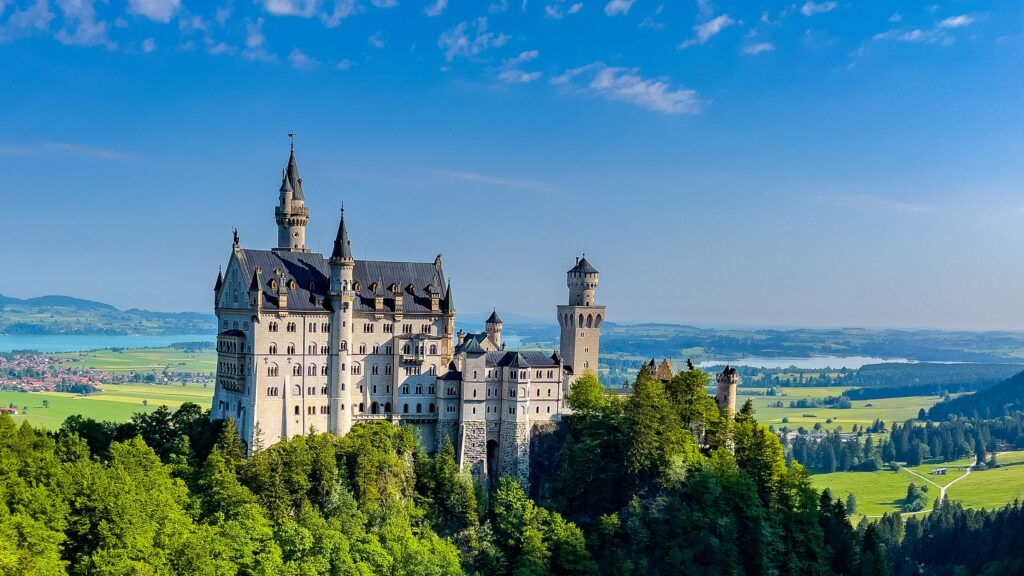
The next stop on our day trip was Linderhof Palace, built by King Ludwig II, it was inspired by Versailles. The small, but elegant, castle is nestled in a deep green forest, and faces a large reflecting pool with a central golden sculpture and terraced gardens. It was a great photo spot.
(TIP: We got dinged $75 by the rental car company because we drove the car into Austria. They had warned us about driving in Austria, an extra fee from them and an extra fee for using the Austrian Autobahn. This was one of the reasons we didn’t drive out to see Hitler’s Eagles Nest. However, Neuschwanstein is in the south of Germany and according to Google, the fastest way to get to Linderhof is to spend 30 miles driving through Austria. We only realized this after the fact when we dropped off the car in Frankfurt. Having said that, driving on the highways and the autobahns in Germany was great. I was happy cruising at 100 mph but you really did have to keep checking the mirror for cars magically appearing on your rear bumper. Many of these guys had to be approaching 150 based on how fast they appeared and then disappeared after I got out of the way.)
We had lunch at Oberammergau, a charming Bavarian village famous for its painted houses. Lüftlmalerei is a traditional folk-art originating in the 1700’s. The fresco’s painted on the houses typically depict religious scenes, but we saw a variety, including a Little Red Riding Hood house. In place of the wooden slat decorations, these houses have ornate painted trim around all the widows, columns and urns, in addition to the primary scene of choice. There were lots of them, not just on homes but also on businesses, and we had schnitzel and kaiserschmarrn, a pancake like thing torn into pieces, caramelized with rum and raisins and served with applesauce) at a painted hotel patio.
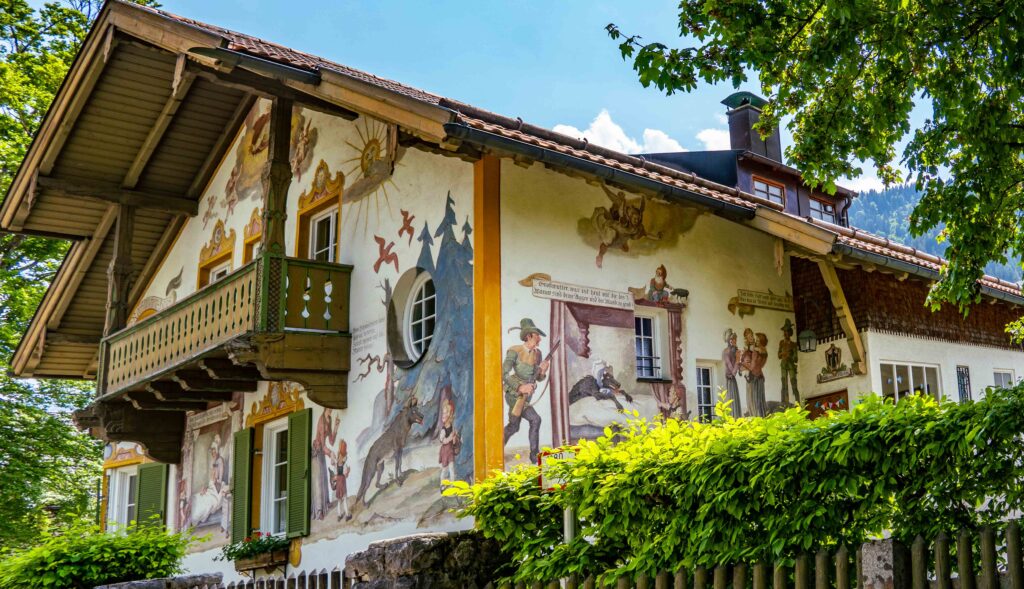
Our final stop of the day was the Pilgrimage Church of Wies. A surprisingly beautiful and wonderfully preserved church from the 1750’s in the middle of nowhere. There is no nearby town of any size and the church is essentially in the middle of a cow pasture. The story goes that in 1738 there was a local miracle. Tears were seen coming from a simple wooden carving of Jesus. A small wooden chapel was constructed to protect the statue but so many pilgrims came to pray that the Abbot at the time decided he needed to build a proper sanctuary. (The inside was beautiful but I didn’t see any signs of tears. Of course, 300 years is a long time to be crying)
On our last day in Munich, we visited Dachau Concentration Camp, it was one of the first German camps opened in 1933. The memorial site is free to visit and is very well done, with a museum in the main building. A provided audio guide had many recordings of experiences recounted by survivors and liberators, most not in English. There are several memorial sculptures on the grounds, two reconstructed prisoner barracks, gas chambers, and crematorium. It was a somber place as you would expect, but I was struck by the contrast of what a lovely natural setting it was for the horrible treatment of all the souls who passed through those gates. If you go to the Camp, we recommend Café Weissenbeck. It is not far, and they have amazing pastries, definitely the best we found in Germany.
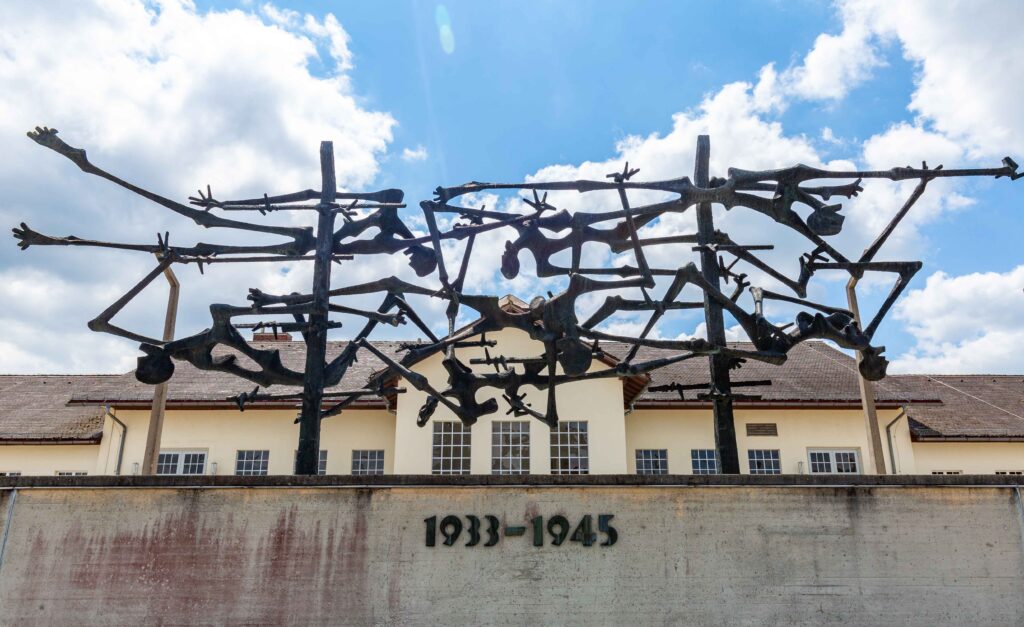
Between Munich and Triberg, we stopped at Sigmaringen Castle. It was a massive sprawling; red roofed structure perched on a shelf above the Danube River in the heart of the city. We took pictures from a bridge and drove on to Hohenzollern castle. This one was sitting on top of a heavily forested hill, so by the time we got to the top, we were too close to take photos, and without paying for a tour we could not get past the tall outer walls. At Lichtenstein we paid the fee for the “grounds only” so were able to see the beautiful views of the city below from the castle walls, and the draw bridge leading to the tower that sat on a sheer cliffside. The castle was in pretty good condition, and not too crowded.
Our overnight in Triberg was the only stop where I could not find an acceptable Airbnb, so we stayed at the “best” hotel in town. We arrived at about 3pm, to find the door locked and no one at the desk, so we wandered around and found a dumpy pizza restaurant for lunch. Returning at 4 o’clock (check-in time) the door was finally unlocked, but there was still no one around. 15 minutes later, an older lady came in and bitched at us, because someone left the door unlocked. We got our room key, and were told there was no “Weefee” aka Wi-Fi. There was also no elevator, stairs that sounded like they were about to collapse, and the room (and the whole town) was dumpy, and tiny. Exactly what I try to avoid.
The one upside was that the room came with a city pass that allowed us free access to four attractions. I’m thinking “City and Attractions” are not appropriate descriptive words for Triberg. Out and about we went to enjoy our freebies in Triberg, famous for cuckoo-clocks and their waterfall. First up was the Triberg Wasserfall, the largest in Germany, it drops 163 meters, in seven tiers. We expected a hike, but it was just a short stroll down a boardwalk, and we were done in less than 15 minutes. (It was amazing how they had fenced off all access to the waterfall so you would have to buy an $8 ticket if you didn’t have the city pass for something that would barely qualify as a waterfall in North America). Next was the Model Train Museum and the Schwarzwald (Black Forest) Museum. It was in a really old building with some seriously creaky floors and stairs, a dusty, musty smelling place with mannequins in traditional garb, including a variety of Gutach Bollenhut, a type of top hat with pom-poms worn by women. There were some life size carved bands that moved and played their instruments if you put some money in, and you could see the mechanism that worked them. There were cuckoo clocks with their inner workings on display as well. (The last of the 4 attractions was the “Instagram museum”. A weird place with a variety of staged props to allow you to take selfies. It was actually kinda fun for the 10 min’s we were inside.)
On our way out of town we stopped at the World’s Largest Cuckoo Clock (with a 14-foot-long bird that weighs 330 lbs) and the House of 1000 Cuckoo Clocks, where they had every size imaginable and we went around turning the hands to see all the different designs. It was actually pretty interesting.
Heidelberg is a pretty town on the river Nektar. The castle, built before 1214, is a crumbling ruin, with some free-standing walls and one round tower where the outer half slid into the moat. There were great views of the Old Bridge and the city below, from one of the castle terraces. As we were taking photos, a guy asked me to take a pic of him and his girlfriend. He then asked me to take a video, and got down on one knee to propose. When he stepped back from her I stopped the video, but quickly restarted when he knelt. Hopefully I did not mess it up too much but I kind of got the feeling this was not the first time (or place) that they had done this.
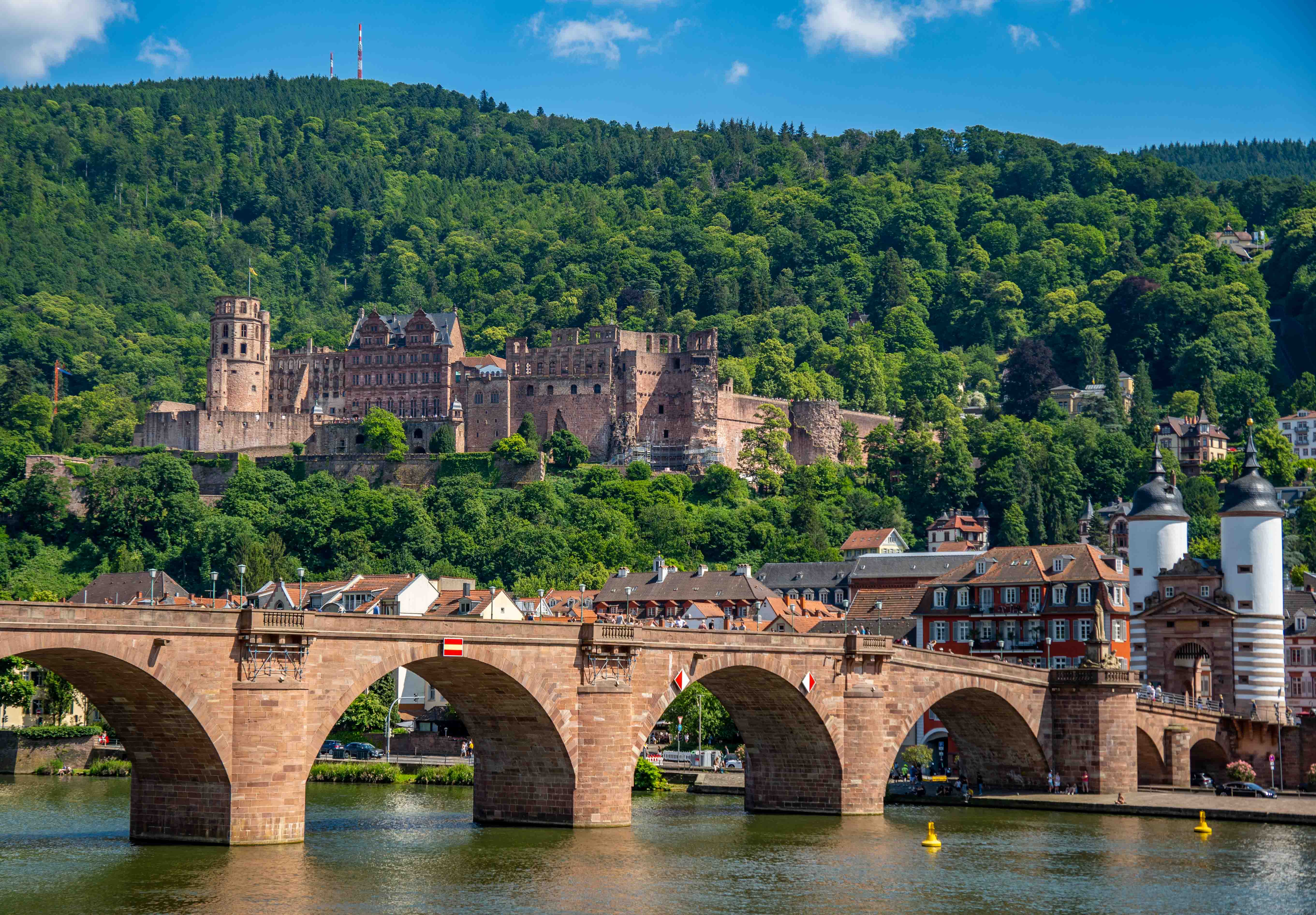
The first stop on our drive to Koblenz was Frankenstein’s Castle (the place has a sordid history but the name led some US soldiers to plan a Hallowe’en party here in the early 70’s and the rest is history. This is now the home of the largest Hallowe’en party in Germany), we drove on a zig zag road up the mountain, that turned into a one lane dirt road with four-foot-tall brush on both sides. If another car had come, one of us would have had to back up all the way. The castle itself is just a shell, with a side chapel that was still mostly intact, and (of course) there is a snack bar/restaurant. Normally you can go inside the castle, but they were setting up for a concert, so it was closed when we were there. Not sure how or why they would hold concerts there, but there were several advertised on posters.
Continuing our drive, we had nine more castles along the Rhine to see before getting to Koblenz (in my defense there were a lot more castles along the route that we could have gone to so I narrowed it down to the best nine – yeah, that reasoning didn’t get me very far with Dessa either), our last town. Fortunately, they were all mostly just get out of the car and take a photo from a distance then keep going. We stopped in Bacharach to climb up the Postenturm Tower, built just for the views of the city, the surrounding vineyards and the Rhine. We also wandered the ruin of Wernerkapelle (Werner Chapel). It was a very cute little town, with lots of turreted, gingerbread buildings with flower boxes along their narrow cobblestone streets.
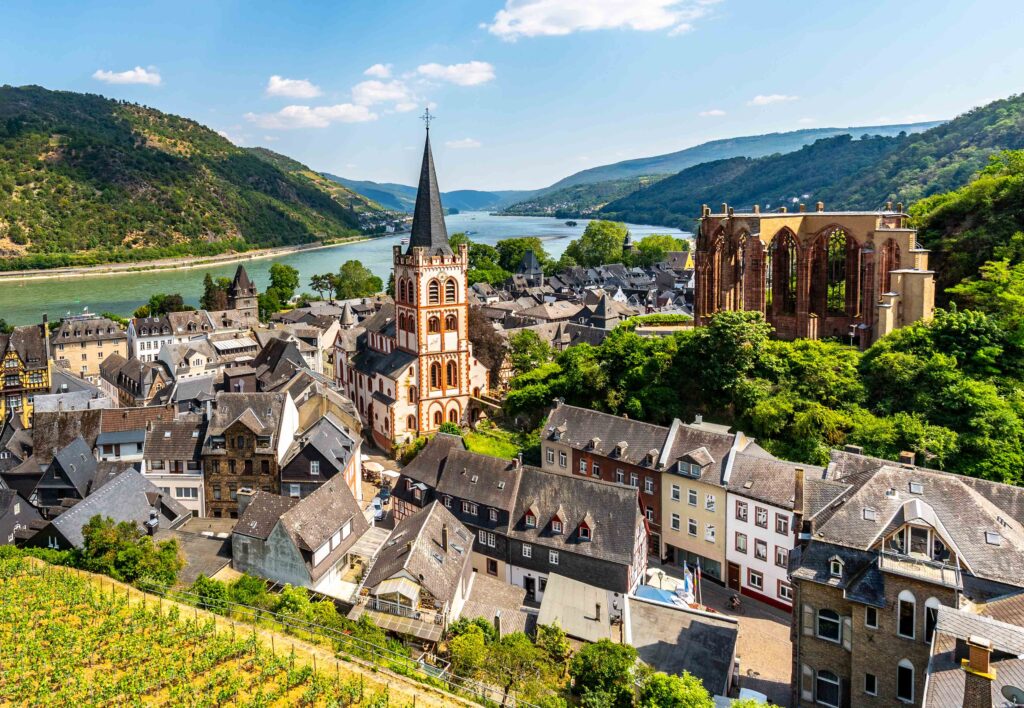
By the time we reached our last stop, Koblenz, I had progressed from ready to go home to “vacation affective disorder”, apathetic and listless. Fortunately, our AirBnB here was wonderful with a large deck overlooking the Rhine where we could watch the cruise ships and other river traffic. It was very nicely decorated; the bed was comfortable and the kitchen was well stocked.
While we did go into Koblenz a few times it was mostly for groceries or restaurants. Both of us had seen enough castles and churches (and other sites). Except for just 1 more day trip. Bill had researched that Eltz castle had one of the better tours so he had saved that one for last, just for me. It was a 3.5 hour round trip where he of course added 2 more castles to the itinerary (hey, we were practically driving right by them). We were not allowed to take pictures inside Eltz, and in the courtyard the buildings were so tall and close they were not very photo friendly either. The oldest part of the medieval castle was erected by the Eltz family in the 12th century, and they still own and occupy the property, 850 years later. It is a Ganerbenburg, a castle divided into houses belonging to joint heirs. It has three “houses” owned by different branches of the family, plus some common area. The castle is built on a rock spur, surrounded by rivers on three sides, so expansion to accommodate additional family could only be done vertically, with some sections eight stories tall. We toured the Rübenach and Rodendorf family wings while Kempenich House is a private residence. It was definitely the oldest castle we visited, and while I’m sure it was the height of luxury in the Middle Ages, I wouldn’t want to live there (ignore her, the tour was very interesting and the castle well built. A recommended stop)
Just in case you ever decide to spend time in Germany or Spain, there are some things you should know. Pillows are nothing like in the US, they are either barely stuffed, or seriously overstuffed, and often huge squares. They do not use top sheets, EVER. Even though the temps were warm at 70’s to 80’s, all beds had duvets. Way too warm, so we took the duvet out and used the cover as a sheet. They were often not soft at all, just like the towels, because clothes dryers are few and far between. For some reason their appliances take forever to wash and/or dry, with a single load taking 3 to 4 hours. They don’t use screens on any windows or doors, and in the warmer months you have to keep them open since air conditioning is rare. They do have metal shutters, usually electric, that come down and completely cover all the windows and doors, blocking out all light. It was like being in one of those houses you see in movies where steel doors slam down to keep out the bad guys. More than half of the places we stayed did not have microwaves, which I guess goes along with the tiny refrigerators, and the fact that they shop for food on a daily basis…except for Sunday’s and the frequent holidays, when everything is closed. Four weeks in Germany was probably two weeks too much (I think that was just the castle fatigue talking. That and all the side trips which meant we didn’t have enough days to simply relax in a park or …). By the last week we were both ready to go home, and still had several towns and a bunch of castles on the itinerary. Tired of the uncomfortable beds, terrible pillows, and German food (I liked the food. Dessa is just mad because the German don’t have enough custard filled pastries) we powered through.
I know I have complained about some of our Airbnb’s, but it is the only way to go if you plan a long trip. Out of 15 stays, we only had 3 that I was not pleased with and some of the things I did not like were cultural differences. We only stayed in hotels 2 nights, (the second being at the Frankfurt airport the night before we flew home) and I would definitely not choose to travel that way, even if you are staying at The Four Seasons or better. I would highly recommend Munich, where there is lots to see and do within day trip range, and Dresden just because it was the city that most felt like what I expected from a European city.
You can see all the photos here (we took over 2000 pictures, but we’re sharing the best 400 with all of you along with a short video since we didn’t take much video in Germany).

Awesome pictures and loved reading all about your trip! Yall really do take the BEST pictures!! Thanks for sharing! ❤️